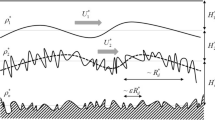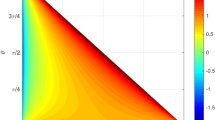Abstract
By using the 3D dynamic equations for small-and meso-scale disturbances, an investigation is performed on the heterotropic instability (including symmetric instability and traversal-type instability) of a zonal line-like disturbance moving at any angle with respect to basic flow, arriving at the following results: (1) with linear shear available, the heterotropic instability of the disturbance will occur only when flow shearing happens in the direction of the line-like disturbance movement or in the direction perpendicular to the disturbance movement, with the heterotropic instability showing the instability of the internal inertial gravity wave; (2) in the presence of second-order non-linear shear, the disturbance of the heterotropic instability includes internal inertial gravity and vortex Rossby waves. For the zonal line-form disturbance under study, the vortex Rossby wave has its source in the second-order shear of meridional basic wind speed in the flow and propagates unidirectionally with respect to the meridional basic flow. As a meso-scale heterotropic instable disturbance, the vortex Rossby wave has its origin from the second shear of the flow in the direction perpendicular to the line-form disturbance and is independent of the condition in the direction parallel to the flow; (3) for general zonal line-like disturbances, if the second-order shear happens in the meridional wind speed, i.e., the second shear of the flow in the direction perpendicular to the line-form disturbance, then the heterotropic instability of the disturbance is likely to be the instability of a mixed Rossby-internal inertial gravity wave; (4) the symmetric instability is actually the instability of the internal inertial gravity wave. The second-order shear in the flow represents an instable factor for a symmetric-type disturbance; (5) the instability of a traversal-type disturbance is the instability of the internal inertial gravity wave when the basic flow is constant or only linearly sheared. With a second or nonlinear vertical shear of the basic flow taken into account, the instability of a traversal-type disturbance may be the instability of a mixed vortex Rossby — gravity wave.
Similar content being viewed by others
References
Bélair, S., D.-L. Zhang, and J. Mailhot, 1995: Numerical prediction of an intense convective system associated with the July 1987 Montreal flood. Part II: A trailing stratiform rainband. Atmos.-Ocean, 33, 475–500.
Bennetts, D. A., and B. J. Hoskins, 1979: Conditional symmetric instability—A possible explanation for frontal rainbands. Quart. J. Roy. Meteor. Soc., 105, 945–962.
Browning, K. A., 1983: Mesoscale structure and mechanisms of frontal precipitation systems. Mesoscale Meteorology, SMHT, Sweden.
Ding Yihui, and Shen Xinyong, 1998: Symmetric instability in non-zonal and non-parallel basic flow. Acta Meteorologica Sinica, 56, 154–164. (in Chinese)
Emanuel, K. A., 1979: Inertial instability and mesoscale convective systems. Part I: Linear theory of inertial instability in rotating viscous fluids. J. Atmos. Sci., 36, 2425–2449.
Hobbs, P. V., 1978: Organization and structure of clouds and precipitation on the mesoscale and microscale in cyclonic storms. Rev. Geophys. Space Phys., 16, 741–755.
Hoskins, B. J., 1974: The role of potential vorticity in symmetric stability and instability. Quart. J. Roy. Meteor. Soc., 100, 480–482.
Ogura, Y., H.-M. Huang, K.-S. Zhang, and S.-T. Song, 1982: Possible triggering mechanisms for severe storms in SESAMEAVE IV (9–10 May 1979). Bull. Amer. Meteor. Soc., 63, 503–515.
Ooyama, K., 1966: On the stability of the baroclinic circular vortex: A sufficient criterion for instability. J. Atmos. Sci., 23, 43–53.
Shen Xinyong, and Ding Yihui, 1998a: Interactions between symmetric disturbance and zonal flow. Part II: Development and diffusion of viscous wave ensemble. Scientia Atmospherica Sinica, 22, 839–848. (in Chinese)
Shen Xinyong, and Ding Yihui, 1998b: Symmetric instability in non-conservative systems. Part II: Forcing effect of weak heating. Scientia Atmospherica Sinica, 22, 274–282. (in Chinese)
Shen Xinyong, Ni Yunqi, and Ding Yihui, 2002: On the problem of nonlinear symmetric instability in zonal shear flow. Adv. Atmos. Sci., 19, 350–364.
Tatsushi, T., 1970: Non-geostrophic and non-hydrostatic stability of a baroclinic fluid. J. Meteor. Soc. Japan, 48, 503–520.
Xu, Q., 1986: Conditional symmetric instability and mesoscale rainbands. Quart. J. Roy. Meteor. Soc., 112, 315–334.
Xu Zixiu, and Wang Pengyun, 1989: Analysis of features and mechanisms of meso rainbands in the front of cold fronts. Acta Meteorologica Sinica, 47, 199–206. (in Chinese)
Zhang, D.-L., and H.-R. Cho, 1992: The development of negative moist potential vorticity in the stratiform region of a simulated squall line. Mon. Wea. Rev., 120, 1322–1341.
Zhang, D.-L., and H.-R. Cho, 1995: Three-dimensional simulation of frontal rainbands and conditional symmetric instability in the Eady-wave model. Tellus, 47A, 45–61.
Zhang Ke-Su, 1988: Mesoscale stability in baroclinic flow. I. Symmectric instability. Acta Meteorologica Sinica, 46(3), 258–266. (in Chinese)
Zhang Lifeng, Wang Liqiong, and Zhang Ming, 2002: Effects of Richardson number on the instability of meso-α vortical wave. Scientia Atmospherica Sinica, 36, 677–683. (in Chinese)
Author information
Authors and Affiliations
Rights and permissions
About this article
Cite this article
Shen, X., Ding, Y. & Zhao, N. Properties and stability of a meso-scale line-form disturbance. Adv. Atmos. Sci. 23, 282–290 (2006). https://doi.org/10.1007/s00376-006-0282-0
Received:
Revised:
Issue Date:
DOI: https://doi.org/10.1007/s00376-006-0282-0




